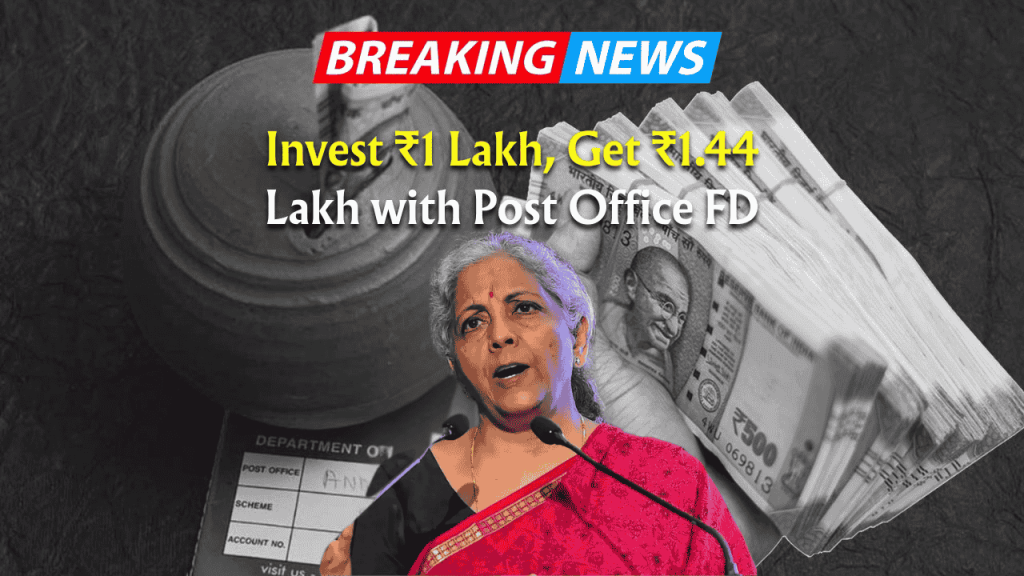
In an era marked by market volatility and fluctuating interest rates, investors in India are increasingly seeking stable, government-backed investment options that provide guaranteed returns. The Post Office Fixed Deposit (POFD) scheme stands out as one such reliable option. In 2025, this scheme offers investors an opportunity to grow ₹1 lakh into ₹1.44 lakh over a 5-year period – all with minimal risk and government backing.
What is the Post Office Fixed Deposit Scheme?
The Post Office Fixed Deposit, officially known as the National Savings Time Deposit Account, is a secure investment plan offered by India Post under the backing of the Government of India. This scheme allows investors to deposit a lump sum amount for a fixed tenure and earn interest at rates that are revised quarterly by the Ministry of Finance.
Key Features of Post Office FD:
- 100% government-backed, extremely low-risk investment
- Available for multiple tenure options: 1, 2, 3, or 5 years
- Interest calculated quarterly but paid annually
- Minimum deposit requirement of just ₹1,000 with no maximum limit
- Tax benefits available under Section 80C for the 5-year FD option
- Can be opened individually or jointly (up to three holders)
- Premature withdrawal facility available after 6 months (with penalty)
- Nomination facility available for smooth succession
Post Office FD Interest Rates in 2025
The interest rates for Post Office Fixed Deposits are reviewed and potentially revised every quarter by the government. As of Q1 FY 2025-26, the rates are particularly attractive for conservative investors seeking stable returns.
Current Interest Rates (As of April 2025)
| Tenure | Interest Rate (per annum) | Maturity Value for ₹1 Lakh | Effective Annual Yield |
|---|---|---|---|
| 1 year | 6.9% | ₹1,06,900 | 6.90% |
| 2 years | 7.0% | ₹1,14,490 | 7.20% |
| 3 years | 7.1% | ₹1,23,000 | 7.30% |
| 5 years | 7.5% | ₹1,44,000 | 8.01% |
| Senior Citizen (5 years) | 8.0% | ₹1,47,500 | 8.30% |
Note: Rates are subject to periodic revision by the Government of India.
These rates compare favorably with many other fixed-income options available in the market, particularly when considering the safety aspect of the investment.
How ₹1 Lakh Grows in Post Office FD Over 5 Years
When you invest ₹1,00,000 in a 5-year Post Office FD at the current interest rate of 7.5% (compounded quarterly), your money grows substantially over time. Here’s a year-by-year breakdown of how your investment would grow:
5-Year Growth Projection
| Year | Principal (₹) | Interest Earned (₹) | Total Amount (₹) |
|---|---|---|---|
| 1 | 1,00,000 | 7,725 | 1,07,725 |
| 2 | 1,07,725 | 8,300 | 1,16,025 |
| 3 | 1,16,025 | 8,970 | 1,24,995 |
| 4 | 1,24,995 | 9,690 | 1,34,685 |
| 5 | 1,34,685 | 9,315 | 1,44,000 |
This progression demonstrates the power of quarterly compounding, where your interest earns interest, accelerating the growth of your investment without any additional deposits or risk.
Who Can Benefit from Post Office FD?
The Post Office Fixed Deposit scheme is particularly suitable for:
- Risk-averse investors seeking guaranteed returns
- Senior citizens looking for stable income
- Tax-payers seeking Section 80C deductions (5-year FD)
- First-time investors testing the waters of financial instruments
- Individuals wanting to diversify their investment portfolio with safe options
- Those saving for medium-term financial goals (3-5 years)
Eligibility and Account Opening Process
Opening a Post Office FD account is a straightforward process accessible to most Indian residents.
Who Can Open a Post Office FD?
| Eligible | Not Eligible |
|---|---|
| Resident Indian individuals | Non-Resident Indians (NRIs) |
| Minors (through guardian) | Foreign nationals |
| Joint account holders (up to 3) | |
| Senior citizens | |
| HUF (Hindu Undivided Family) |
Documents Required:
- Aadhaar Card (for identity and address proof)
- PAN Card (mandatory for deposits over ₹50,000)
- Passport-size photographs (2-3 recent photos)
- Existing Post Office savings account details (optional but recommended)
- Completed account opening form (available at post offices)
Steps to Open a Post Office FD:
- Visit your nearest post office branch
- Collect and fill the account opening form (Form A)
- Submit required documents along with the deposit amount
- Choose your preferred tenure (1, 2, 3, or 5 years)
- Nominate a beneficiary (optional but recommended)
- Receive your FD certificate or passbook
You can also manage your account through the India Post Payment Bank (IPPB) mobile application if you’re registered for digital services, though initial account opening typically requires a visit to the post office.
Comparison with Other Fixed Income Instruments
When evaluating investment options, it’s important to compare the Post Office FD with other available fixed-income instruments to make an informed decision.
Comparative Analysis
| Investment Option | Risk Level | Interest Rate (2025) | Tenure | Tax Benefits | Liquidity |
|---|---|---|---|---|---|
| Post Office FD | Very Low | 6.9% to 7.5% | 1 to 5 years | Yes (5-yr FD) | Medium |
| Bank FD | Low | 6.0% to 7.0% | 1 to 10 years | Yes (5-yr FD) | High |
| PPF | Very Low | 7.1% | 15 years | Yes (EEE) | Low |
| SCSS (60+ age) | Very Low | 8.2% | 5 years | Yes | Medium |
| Mutual Funds (Debt) | Moderate | 7-9% (market linked) | Flexible | No | High |
As evident from the comparison, the Post Office FD offers a balanced combination of safety, returns, and moderate liquidity compared to most other fixed-income options.
Advantages and Limitations of Post Office FD
Like any investment product, the Post Office Fixed Deposit scheme comes with its own set of advantages and limitations that investors should consider.
Advantages:
- Sovereign Guarantee: Backed by the Government of India, ensuring complete safety
- Attractive Interest Rates: Often higher than many bank FDs
- Quarterly Compounding: Enhances the effective yield
- Tax Benefits: 5-year FD eligible for tax deduction under Section 80C
- Low Minimum Investment: Start with just ₹1,000
- Nomination Facility: Ensures smooth transfer to beneficiaries
- No TDS: Unlike bank FDs, no TDS is deducted on interest earned
Limitations:
- Limited Inflation Protection: Returns may not always beat inflation
- Taxable Income: Interest earned is taxable as per your income tax slab
- Limited Accessibility: Not all post offices offer digital services
- Premature Withdrawal Penalties: Early withdrawal comes with interest penalties
- Unavailable to NRIs: Only resident Indians can invest
- Fixed Interest Rate: Cannot benefit from any future rate increases
Tips to Maximize Returns from Post Office FD
To optimize your investment in Post Office FDs, consider implementing these strategies:
- Ladder Your Investments: Distribute your funds across different tenures to balance liquidity and returns
- Choose the 5-Year Option: For the highest interest rate and tax benefits
- Reinvest at Maturity: Compound your returns by reinvesting the maturity amount
- Senior Citizen Advantage: Eligible senior citizens should utilize the higher interest rates
- Time Your Investments: Consider investing when interest rates are at their peak
- Use the Tax Benefit: Maximize your Section 80C deductions with the 5-year FD
- Combine with Other Options: Pair with other post office schemes for a balanced portfolio
Practical Applications of Post Office FD
The Post Office FD can serve multiple financial planning purposes:
- Emergency Fund: A portion of your emergency corpus in 1-year FDs
- Tax Planning: 5-year FD for Section 80C benefits
- Children’s Education: Medium-term savings for educational expenses
- Senior Citizen Income: Regular interest income for retirees
- Goal-Based Savings: Saving for specific medium-term goals like home renovation
Conclusion
In 2025, the Post Office Fixed Deposit scheme continues to be a compelling investment option for those seeking stability and guaranteed returns. With the potential to grow ₹1 lakh into ₹1.44 lakh over 5 years, it offers an attractive proposition for risk-averse investors.
While it may not match the potentially higher returns of market-linked instruments, its government backing, tax benefits, and stable returns make it an essential component of a well-diversified investment portfolio. For senior citizens, first-time investors, and those seeking tax benefits, the Post Office FD remains one of the most reliable fixed-income options available.
As with any investment decision, consider your financial goals, risk tolerance, and overall portfolio strategy before investing. The Post Office FD, with its balance of safety and returns, continues to stand the test of time as a trusted investment vehicle for millions of Indians.
Frequently Asked Questions
- What is the minimum amount needed to open a Post Office FD? The minimum deposit requirement is ₹1,000 with no maximum limit.
- Can NRIs invest in Post Office Fixed Deposits? No, Post Office FDs are only available to resident Indians.
- Is premature withdrawal allowed in Post Office FD? Yes, after 6 months, but with an interest penalty.
- Are Post Office FD interest rates fixed throughout the tenure? Yes, the rate applicable at the time of investment remains fixed until maturity.
- Is the interest earned on Post Office FD taxable? Yes, the interest is taxable as per your income tax slab.
- Can I get a loan against my Post Office FD? No, unlike bank FDs, loan facility is not available against Post Office FDs.
- How often is interest compounded in Post Office FD? Interest is compounded quarterly but paid annually.
- Can a minor open a Post Office FD account? Yes, through a guardian.
- Is nomination facility available for Post Office FD? Yes, nomination facility is available and recommended.
- How do I check the balance of my Post Office FD? Visit your post office branch or check through the India Post online portal if registered.





